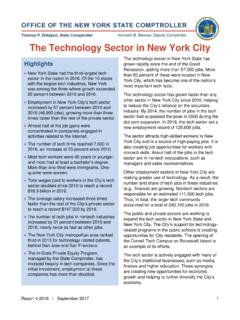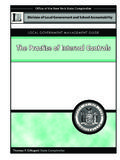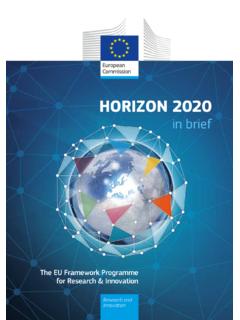Transcription of Office of the NEW YORK STATE COMPTROLLER
1 New York STATE ComptrollerTHOMAS P. DiNAPOLICOMPTROLLERO ffice of the NEW YORK STATES mart Solutions Across the STATE : Advanced Technology in Local GovernmentsSEPTEMBER 2019 Table of ContentsIntroduction 1 smart Connectivity 3 Online Systems 3 Bill Paying ..3 Interactive Communication ..3 Social Media ..4 Public Wireless Internet and Municipal Broadband 4 Street smart 5 Parking Enforcement 5 Street Lights 6 GPS on Municipal Equipment 8 Vehicle-to-Infrastructure Technology 8 Safety smart 10 Enhanced 911 10 Drones 11 Book smart 12 Schools 12 Libraries 13 smart Utilities 14 Electrical Grid Modernization 14 Drinking Water Systems 15 Sewer Systems 16 Cybersecurity and Planning 17 Notes 19 Division of Local Government and School Accountability Contacts 251 Industrial Development AgenciesSmart Solutions Across the STATE : Advanced Technology in Local GovernmentsIntroductionNew technologies continue to reshape how local government services are delivered across the STATE .
2 Local officials are working to meet the evolving expectations of citizens who want their interactions with local government to match the ease and convenience with which they manage their personal business. At the same time, officials are motivated to leverage advanced technologies (often called smart technology ) to gain operational efficiencies. When successful, these efficiencies have the potential to free up resources for other critical needs, help leaders hold the line on taxes and encourage new growth and 2016 White House report emphasized that technological innovations provide an opportunity to revamp how cities operate at all levels and for all stakeholders. 1 Cities provide residents a variety of critical services, control important infrastructure and have a vested interest in providing modern and efficient public services. Some cities, for instance, have started integrating automatic sensor controls and remote metering into water treatment and delivery, putting in place infrastructure that could enable safer vehicle-pedestrian interactions in busy downtowns, and using mobile phone applications (apps) to make it easier for citizens to do everything from paying for parking to reporting dangerous potholes.
3 Villages, towns and counties, which often provide at least some of the same services, are also using comparable technologies. School districts and libraries have been investing in an array of new technologies in an effort to facilitate learning and Local government smart technology often includes devices and applications that collect and use large amounts of data in real time. Many municipalities are enhancing their parking services, street lighting and vehicle fleets with new technologies. Over half of New York s cities allow homeowners to pay their property taxes and other municipal bills over the internet. School districts and libraries are increasing their use of technology to enhance operations and benefit their communities. Customary elements of good governance, including stakeholder communications, well-designed procurements and robust internal controls, may be especially critical when adopting new technologies. As they implement smart technology, local governments must consider cybersecurity to protect their assets and their residents private Technologies in Local Government2 smart Solutions Across the STATE : Advanced Technology in Local GovernmentsIncorporating smart technology, however, has also opened the door to significant new risks.
4 Many of the systems generate and collect massive amounts of data about both residents and government operations. As stewards of the public s security and privacy, local officials face heightened challenges and responsibilities to ensure privacy while simultaneously storing, analyzing, sharing and applying this data, and building staff and infrastructure In addition, the very novelty, complexity and scope of new and emerging technologies can augment the challenges local governments typically face in striving to use public resources wisely and deliver services effectively while ensuring transparency and report provides a broad overview of the ways that local governments in New York are adopting smart technologies. In order to share information about projects that potentially appeal to the widest array of local governments statewide, it focuses on areas of general government operations, such as local roads and public safety, and on K-12 education.
5 Generally, programs specific to New York City and specialized functions of certain types of local government, such as correctional facilities or community colleges, are not featured. Finally, this report does not make any recommendations for or against these technologies generally, although OSC does often comment on specific applications in its audits and provides training and guidance on related topics, including cybersecurity policy and industrial control Development AgenciesSmart Solutions Across the STATE : Advanced Technology in Local GovernmentsSmart ConnectivityLocal governments in New York STATE have been increasing their own online presences and capabilities. At their simplest, municipal websites post legally required information such as annual budgets, meeting dates, financial reports and independent However, some offer a variety of additional services SystemsOSC reviewed the official public websites for all of New York s 62 cities, and the 25 towns and the 25 villages with the largest populations, to determine the types of online payment and communication services provided and (for a more limited number) the types of social media outlets Bill PayingMany of New York s cities allow homeowners to pay their property taxes and other municipal bills, such as water, sewer and parking tickets, over the internet.
6 They do this either through a government-owned payment system or a third-party Similar payment options are often available in large towns and villages. Compared to traditional forms of remittance cash, checks and money orders making payments online can be faster and more convenient for taxpayers. Methods of payment include electronic bank-to-bank transfers and debit and credit CommunicationCities and larger towns and villages may also offer interactive online communication. Unlike simple email correspondence, this feature allows residents to, among other things, directly make service requests, report code violations or send questions to specific municipal departments. These communication services vary in terms of what residents can ask, request and report. Some require users to create an account, in which they provide some personal information, such as first and last name, phone number, email address and, in some cases, a home or business address.
7 Local governments often contract with third-party vendors to provide the software for tracking requests and complaints and their resolutions. 4 smart Solutions Across the STATE : Advanced Technology in Local GovernmentsSocial MediaA growing number of local governments have established a social media presence to improve their communications. Some local governments in New York STATE have Facebook and Twitter accounts where they post road closures, weather warnings, emergency alerts, local news and community events. Public Wireless Internet and Municipal BroadbandIn addition to what they provide online, local governments are doing more to ensure that their residents, visitors and businesses have better access to the internet. Some of the STATE s municipalities are implementing public Wi-Fi (wireless internet access) and getting more directly involved with broadband infrastructure. Some cities, including Albany and Buffalo, are meeting the demand for free public Wi-Fi on a large Through partnerships with local private telecommunication companies, these cities currently provide free high-speed Wi-Fi access to residents and visitors in select areas (known as hotspots ), usually located in downtown areas and busy corridors.
8 In addition, some public libraries offer visitors the ability to connect to the internet at no cost with their laptops, smart phones and other devices. The ways citizens connect to these networks and the length of their access can access has become a key component in providing education and health care, managing energy resources and ensuring public safety. It is also important for economic Rural communities sometimes lack access to broadband internet, having neither cable nor fiber optic New York STATE has committed to bringing broadband to previously unserved rural areas and achieving universal broadband However, even in cities and suburbs, not all areas are equally well-served, with some neighborhoods suffering from a lack of investment in broadband that performs with even the minimum standard of reliability and speed. In those underserved urban pockets, some local governments have begun investigating options for municipal broadband, where the municipality establishes and owns the network and sells the subscriptions to homeowners and The City of Albany and Erie County have both conducted feasibility studies of investments in municipal City of Ithaca is an example of a local government with a large and expanding online footprint.
9 The City s website offers homeowners the ability to pay their property taxes and other fees, request services, report problems, and submit online forms and Also, residents can create user accounts to keep track of their interactions, including any requests or submissions. Ithaca also has an active social media presence with separate departmental accounts where residents can comment directly to the Mayor or the Police Development AgenciesSmart Solutions Across the STATE : Advanced Technology in Local GovernmentsStreet SmartTransportation is a major factor influencing a community s overall quality of life, environment and economy. Particularly in cities, the ways people navigate the streets not just how well the roads are maintained for drivers, but how easy it is to find parking, use public transit and walk safely affect how livable a place is. Among other initiatives, municipalities are installing more energy-efficient street lighting and adopting smart technologies to help them ensure proper enforcement of parking restrictions, regulate traffic flow, and use municipal vehicles to collect road maintenance data.
10 Parking EnforcementMany municipalities have replaced the traditional coin-operated parking meter with some form of electronic parking meter. These come in a range of alternatives, including multi-space parking and single space meters. The meters can have options such as allowing payment by credit or debit card, being multilingual, providing the ability to call 911, or even having cameras that record use of the parking spot and support remote In addition to allowing direct payment through the meter or kiosk, these systems often allow drivers to create user accounts on a smart phone app, and then enter vehicle, personal and payment information. Some mobile app services allow drivers to receive alerts on their phones to renew their parking session before it expires and to pay remotely. Also, when fully integrated into the municipal parking network, apps can provide a find parking feature that directs vehicles to empty spaces (such as in a garage) when appropriate.
















